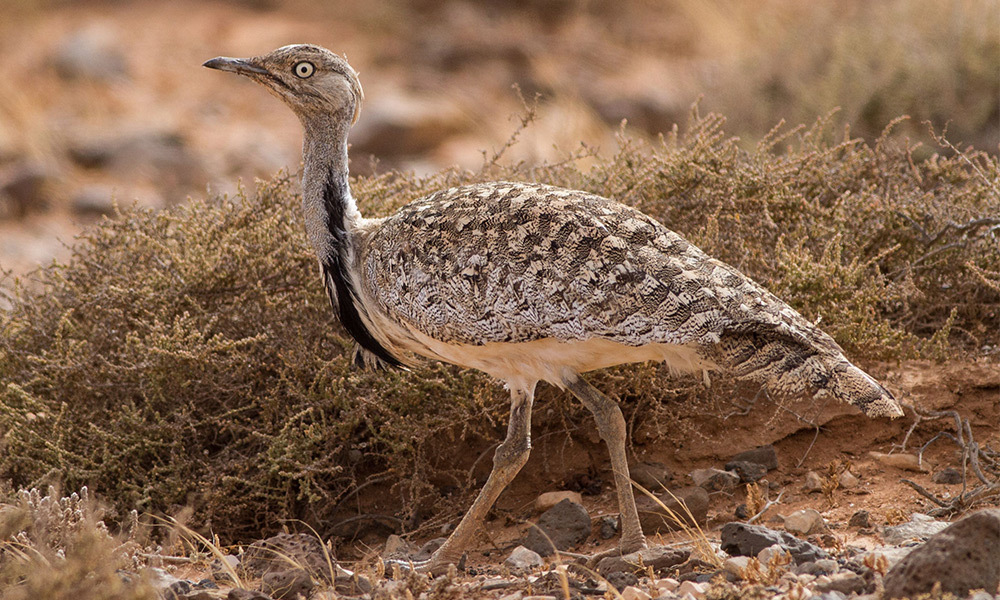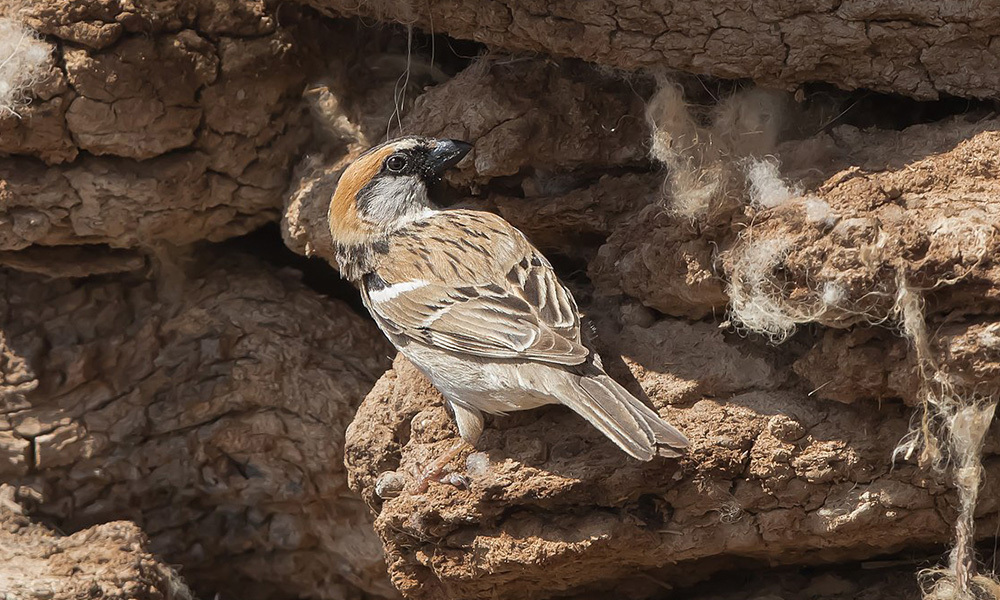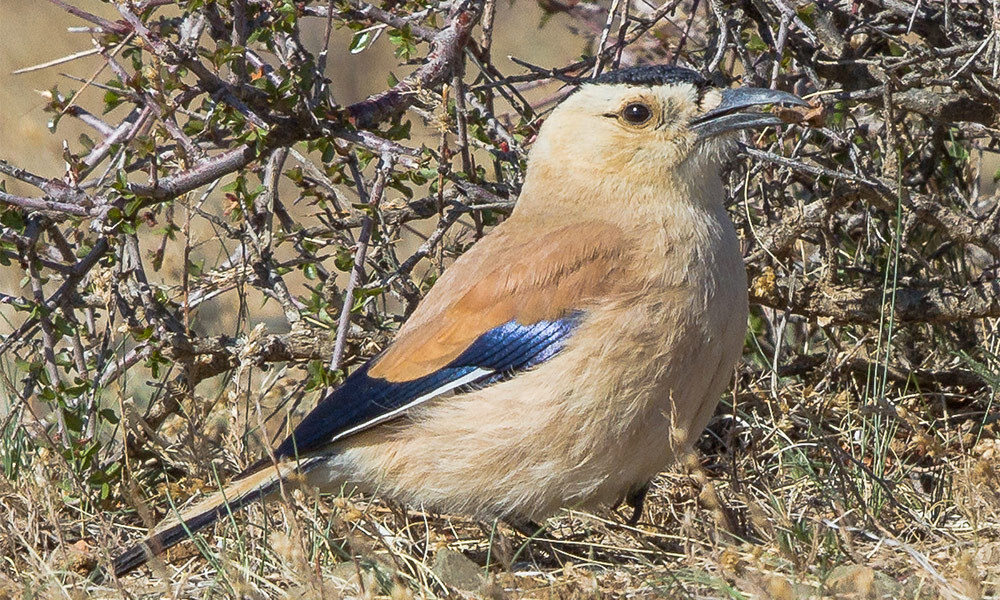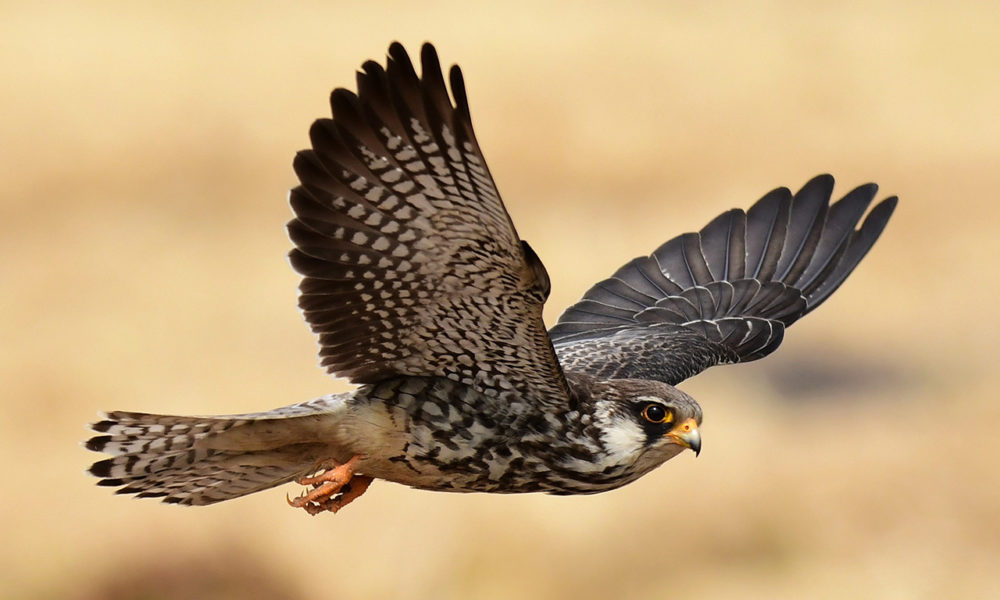With 513 species, the birds of Mongolia are minor in number when compared to those of, say, India, with more than 1,300. However, the diversity of Mongolia’s is vast, with more than 60% being migratory, coming from far—and high. Some species travel here from oases in Africa, while Bar-headed guy fly above 26,000 feet, over the towering peaks of the Himalaya, to reach their summer grounds, where they raise their young. There are few endemic species in Mongolia, and approximately 50 to 60 species roam the skies of the Gobi Desert. Here are some of the most interesting must-see birds among Mongolia’s species.

Houbora Bustard
There are two species of bustards in Mongolia, the Great Bustard and the Houbora Bustard. Houbora bustards are smaller, yet like other bustards, it has a spectacular display, raising the white feathers of the head and throat while withdrawing the head. They are considered globally threatened—with numbers somewhere between 200 and 300—due to degradation of habitat and hunting at the places these birds stop while migrating. They inhabit semi-desert and valleys between mountains up to 8,000 feet above the sea level, and Mongolia is the only country where Houbara Bustard is not formally hunted. However, there is some evidence of poaching.
Bearded Vulture
Also known as Lammergeier, the bearded vulture is a bird of prey inhabiting a broad area from northern Africa to Mongolia. The population continues to decline and is classified as near threatened. It’s unique diet consists of 70 – 90% percent bone and bone marrow. They are common in the mountainous regions in Africa, Central Asia, the Tibetan highlands, and Mongolia’s Altai Mountains. Mostly they live at an elevation between 3,300 and 16,000 feet above the sea level. During warm summer days they roam skies of the Gobi looking down for food. Quite a massive bird, its wingspan reaches as much as 9.3 feet. You can see this bird at beautiful Yol Valley National Park when you hike through it.

Saxaul Sparrow
Commonly found in remote parts of Central Asia, the Saxaul Sparrow is a handsome little bird found in deserts, especially around rivers and oases. It is usually found around shrubs such as saxaul (Haloxylon), poplar (Populus), or tamarisk (Tamarix). The saxaul sparrow is less social than other sparrows while breeding, due to its dry habitat and its choices of nesting locations: holes in trees and earth banks. The breeding season is short, lasting from May to July, with most young raised in April and June. Little is known of its behavior because of its remote habitats, and because it spends much of its time hidden in foliage. Yet when breeding, the Saxaul Sparrows have in Mongolia have been observed to withdraw less.
Wall Creeper
A small bird found in mountainous areas in Europe and Asia at elevations ranging between 3,300 – 9,800 feet above the sea level, the wall creeper is an insectivore, feeding on terrestrial invertebrates, primarily insects and spiders. Feeding birds move across a cliff face in short flights and quick hops, ascending with a quick jerk of its wings. With its long, downcurved bill it is uniquely adapted to claiming insects from within minute holes and crevices along rock faces. In the Gobi, the Wall Creeper inhabits the beautiful Yol Valley National Park, but it is quite challenging to spot them with the naked eye. So please bring your binoculars.
Saker Falcon
A beautiful large species of falcon, the Saker Falcon occurs across a wide area ranging from Central Europe eastward to Northeastern China. Its terrain includes open grasslands with nearly trees or cliffs, and it feeds mainly on rodents and smaller birds. It nests in cliffs, trees, rock crevices, ledges, and even atop artificial structures such as electric poles, buildings, bridges and towers. It will also lay its eggs in the abandoned stick nests of other birds such as Upland Buzzards, Common Ravens, among others. Globally threatened (Red List Category: Endangered) the Saker is declining due to degradation of its habitat.

Mongolian Ground Jay
This bird is far from a typical jay–with its long, slightly de-curved bill, flashy black-and-white wings, and ground-loving behavior. A beautiful species, it is sandy brown overall with a black crown and a thin dark line behind the eye. It is among Mongolia’s endemic species, inhabiting open, dry steppe land and high-altitude semi-desert, where it forages on the ground but often perches up on exposed boulders or snags. They can also be seen at the rolling hills just north of the Hongoryn Els sand dunes.
Amur Falcon
Breeding in East Asia and Northern Mongolia, the Amur Falcon is a small raptor of the falcon family characteristically a dark sooty gray. They migrate in a broad front through India and Sri Lanka, sometimes further east over Thailand and Cambodia and then over the Arabian Sea, sometimes in passage on the Maldives and other islands to reach southern Africa. Their annual journey is the longest sea crossing of any raptor. More than 1,000,000 Amurs roam the skies of the world, feeding mainly late in the evening or early in the morning capturing a wide range of insects in the air or on the ground.

